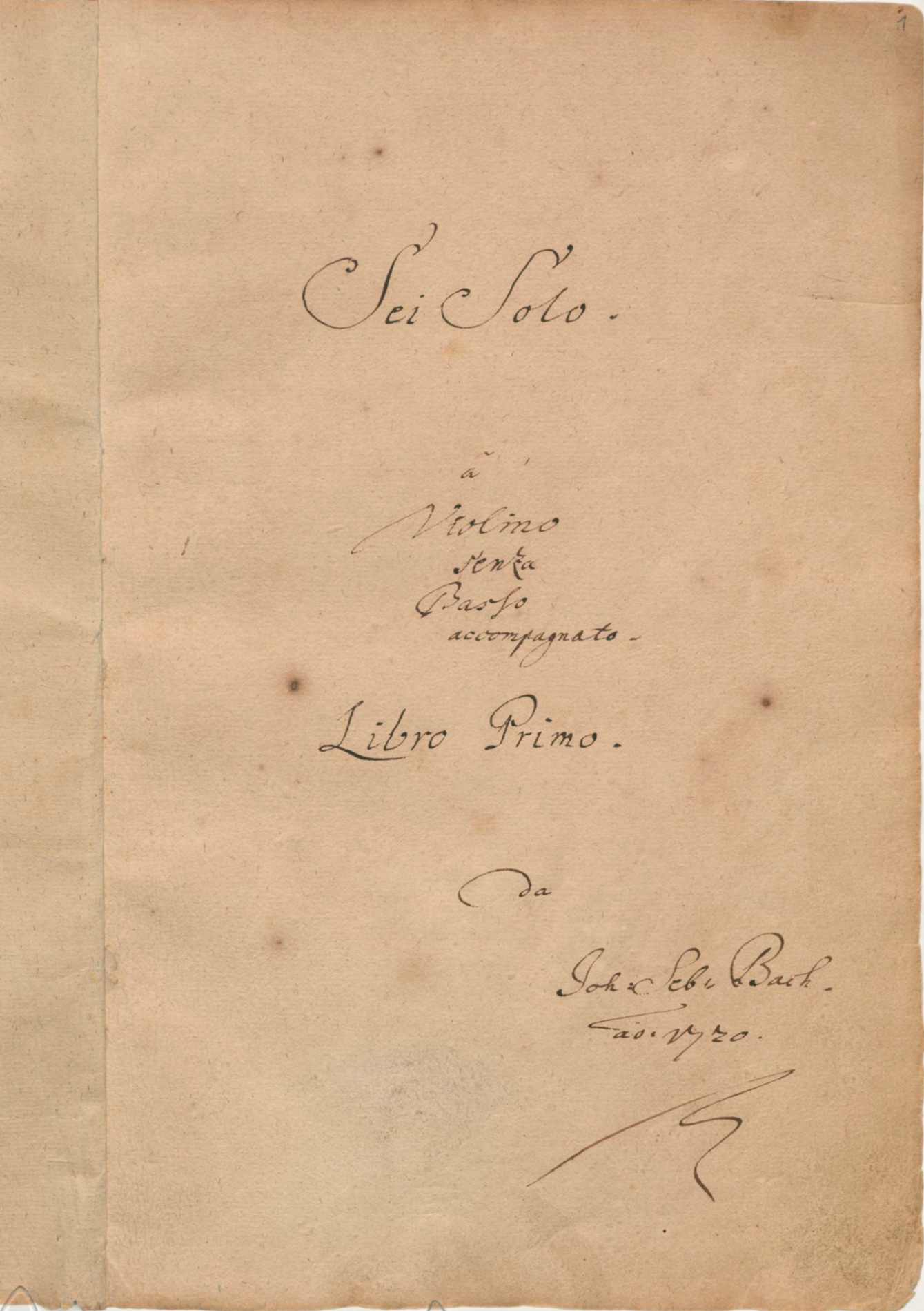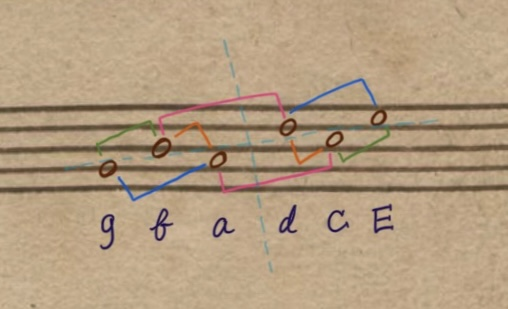back to Table of contents
J.S. Bach was offered to the post of Kapellmeister on 1st August 1717 by Prince Leopold of Anhalt-Köthen, a good judge of music and a first-rate amateur, and he held the position for about six years.1
"Sei Solo. ã Violino senza Basso accompagnato. Libro Primo.", the Six Sonatas and Partitas for Solo Violin was composed after the unexpected death of Bach’s first wife, Maria Barbara in 1720. Bach spent his early summer in a Bohemian town called Carlsbad (Karlovy Vary) with Prince Leopold of Anhalt-Köthen, and when Bach returned from this business trip accompanying the prince, he learned that his wife Maria Barbara had perished after a short illness and already been buried. The exact cause of her death is still unknown.2
Their son Carl Philipp Emanuel, who was six at the time, later described his father's experience of returning home and 'finding her dead and buried, although he had left her hale and hearty on his departure. The news that she had been ill and died reached him only when he entered his own house.' As far as we can tell, theirs had been a close and harmonious marriage ('blissful', according to Emanuel), and she had been both a link to his family roots and a stabilising influence during his unsettled years of employment in Arnstadt, Mühlhausen and Weimar.3
Albert Schweitzer, in his J. S. Bach Volume I wrote "All her husband could do was to make a pious pilgrimage to the grave of her who for thirteen years had been the faithful and devoted sharer of his lot. Of the seven children that Maria Barbara had born to him, four were living at the time of her death; the eldest, a daughter named Katharina Dorothea, was twelve years old; Wilhelm Friedemann was ten; then came Philipp Emmanuel and his brother Johann Gottfried Bernhard, who was about a year younger than he."4
Alleged to depict J.S. Bach during his tenure as Capellmeister to Prince Leopold of Anhalt-Köthen, between 1717 and 1723, by Johann Jakob Ihle. The painting was identified in 1905. Its identification as a picture of J.S. Bach was only guesswork and has been strongly opposed, doubts over its authenticity being based partly on the geographical distance between the portraitist, who came from Esslingen and worked for a time at the Bayreuth court, and Prince Leopold of Anhalt-Köthen, who presumably commissioned this large portrait, and partly on the difficulty of reconciling the latest possible date of commission (1722/23) with the artist’s dates (1702-1774). On the other hand Freyse has presented all the essential arguments: for its authentication and dating (1720) with complete expertise. On the evidence of ophthalmological links in the chain of facial evidence even Besseler has included it in his "Five Genuine Portraits".
In 1897 it was discovered by chance by the Bamberg conservator Max Hartmann in the house of a master baker in Bayreuth, whose grandfather had been a gardener at the new castle from about 1820 to 1830 and apparently acquired some discarded paintings. After Hartmann had restored it, it was bought by Oskar von Hase, director of the publishers Breitkopf & Härtel in Leipzig, and in 1907 given to the newly opened Bach-Museum in Eisenach. Otto Landmann was the first to report on it in the same year.5
Sei Solo is an Italian word meaning six unaccompanied works, but in that case, solo should be written in the plural Soli, whereas it is written in the singular Solo. Since the Italian language often omits the subject, could we think that Bach has likely intended (Tu) Sei Solo... "You are alone"...??
Anner Bylsma describes "A score like the Sei Solo a Violino senza Basso accompagnato can only be understood as a kind of code, a cypher, a secret message from one violinist (Bach) to another."6
There is unfortunately no evidence that Bach ever played the Sei Solo himself on the violin. The only proof we have about Bach playing the Sei Solo is from his student Johann Friedrich Agricola reported in 1775: "The author himself often played them on the clavichord and added as much harmony as he found necessary." 8
"Baroque music always had a basso continuo." Organist Reitze Smits talks about Prelude and Fugue in D minor BWV 539 which the fugue is based on the second movement of Sonata for violin solo, BWV 1001. “Bach originally composed this piece for violin, but later decided to adapt the piece for organ so that the organist could play what he had in mind when writing it for violin. It’s difficult to play this on a violin, especially the chords. The bow goes across one after the other to the fourth.”9
There are several surviving manuscripts of Sei Solo, with four main sources: An autograph written in Bach's own hand, a copy by his second wife, Anna Magdalena Bach made bewteen 1727 and 1731, a copy by Johann Peter Kellner, dated 1726, and a copy by two unknown copyists, made in two stages: BWV 1001-1005 copied 1721 or later, BWV 1006 copied in the late eighteenth century. Once thought to be a Bach autograph, this is the manuscript that the music collector Georg Poelchau discovered in St. Petersburg in 1814, in a stack of papers earmarked for wrapping up butter.11
David Ledbetter says, "Whatever the order of composition, Bach habitually arranged his collections in some coherent pattern of keys. In the autograph and Anna Magdalena's copy, Sonatas and Partias alternate in a key scheme: g-b-a-d-C-E. This has a neat palindromic shape in that the first three keynotes go up a 3rd and down a 2nd, and taking the second three as a mirror image (E-C-d) the keynotes go down a 3rd and up a 2nd. Taking the Sonatas and Partias separately (g-a-C: b-d-E), there is the same sequence of two minor keys and one major key, and another palindromic arrangement of keynote relations."13
_______________
1Johann Nicolaus Forkel, On Johann Sebastian Bach’s Life, Genius, and Works (London, Harcourt, Brace and Howe, 1920), p.20.
2https://www.bach-leipzig.de/en/neutral/johann-sebastian-bach-%E2%94%80-chronology, last visited 24th February, 2025.
3John Eliot Gardiner, Music in the Castle of HeavenーA Portrait of Johann Sebastian Bach (U.K., Penguin Books, 2014), p.189.
4Albert Schweitzer, J. S. Bach Volume I (The Macmillan Company, 1905), p.107.
5https://www.bach-cantatas.com/Memo/B-07.htm, last visited 3rd March, 2025.
6Anner Bylsma, Bach senza Basso, About the solo works for violin of Joh. Seb. Bach (Utrecht, Bylsma's Fencing Mail, 2012), p.7.
7https://www.bach-digital.de/receive/BachDigitalSource_source_00001955, last visited 24th February, 2025.
8„[Bach] spielte sie selbst oft auf dem Clavichorde, und fügte von Harmonie so viel dazu bey, als er für nöthig befand.“
9https://www.bachvereniging.nl/en/bwv/bwv-539, last visited 24th February, 2025.
10Joel Lester, Bach’s Work for Solo Violin- Style, Structure, Performance (USA, Oxford University Press, 2003), pp.11-12.
11David Ledbetter, Unaccompanied Bach : performing the solo works (Yale University Press, 2009), pp.4-5.
12ibid., p.3.
13ibid., p.11.
Next: Chapter II. Symbolism and Allegory?
back to Table of contents








